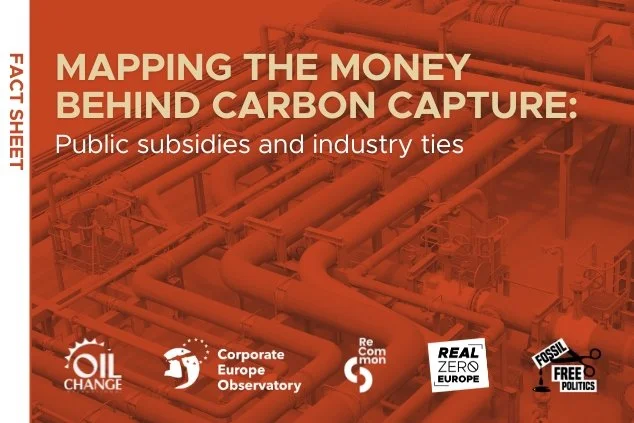Climate Law fails to provide real solutions to reach real zero
[Brussels, July 2, the hottest day of the year so far] – In response to the update of the EU’s Climate Law, Real Zero Europe (RZE) issues the following statement in regard to the "net-zero" agenda and promotion of harmful practices:
“Companies delaying their transition to reduce emissions were given a lifeline with the loopholes in the new Climate Law. From outsourcing climate efforts outside the EU to labeling burning forests as "clean energy", decidedly harmful solutions are being promoted” said Tiziano Biagi, Communications Coordinator at Real Zero Europe.
The Climate Law proposes a new 2040 target of 90% reductions compared to 1990 levels. However, the proposal directly contradicts this apparent ambition with various loopholes.
The EU returns to a well-known greenwash allowing international offsetting
The first loophole is through an old and failed approach - purchasing offset credits from countries outside of Europe. Every credit allowed is one tonne of CO2 emissions that polluting industries can emit.
Despite the call from over 80 NGOs to reject offsetting in the EU, starting from 2036, the proposal allows up to 3% of emissions to be offset. This represents a large amount of GHGs, roughly the size of Austria and Greece’s current emissions combined.
“Carbon offsets fundamentally undermine emissions reductions, forest protection, as well as human and collective rights. Promoters cannot credibly claim offsets to reduce emissions in any significant or meaningful way. Calculations rely on exaggerated baselines and/or hypothetical future scenarios that cannot be proven. Such false solutions must be abandoned if the world is to move forward in an effective and just manner,” states Joanna Cabello, climate justice senior researcher at SOMO.
Geo-engineered to fail: Technological removals endorsed by the EU
A new loophole in the proposal is the promise to review post-2030 climate legislation to add “permanent removals” under the EU’s carbon market. Permanent removals, or activities purported to take carbon out of the atmosphere for very long periods of time, are also known under the name Carbon Dioxide Removal (CDR).
Belén Balanyá, climate justice researcher and campaigner, Corporate Europe Observatory, said: “Integrating carbon removals into the carbon market is nothing short of carbon welfare. It rewards the very same energy intensive industries that have been sprayed with cash for the last 20 years for continuing polluting. Unfortunately climate law in Europe is - again - largely written by big polluters and its commitment to false solutions to the climate disaster.”
Martin Pigeon, Forests & Climate campaigner with Fern, said: “The reality is that most carbon removals today consist of applying wood charcoal to soils. Known as biochar, this represents more than 90% of the CO2 credits delivered on voluntary markets. It is difficult for any carbon dioxide removals technology to be cheaper than wood charcoal, but we need to think beyond the financial cost: when biochar is produced at the expense of forests, it makes the climate crisis worse, not better.”
Today, the CDR technologies most mentioned in EU climate policy and modelling are based on Carbon Capture and Storage (CCS), with CO2 resulting from the combustion of biomass (Bioenergy with Carbon Capture and Storage or BECCS), or directly captured from the atmosphere (Direct Air Carbon Capture and Storage, DACCS).
But these technologies remain mere promises at this stage, because it would take billions and billions of euros in public funding to build such risky infrastructure. BECCS and DACCS currently only deliver ridiculously low amounts of CO2 uptake, are yet to demonstrate reliability at the industrial scale, in the case of DACCS use immense amounts of energy that could be used to replace fossil fuels, and the CCS technology they are based on is prohibitively expensive, has persistently failed to advance in over 50 years - both in terms of capture rates and storage integrity - and pose a risk to human health. A recent forecast by a Norwegian think tank found CCS’s failure rates are actually going up.
Myriam Douo, senior campaigner at Oil Change International, said: "Wasting precious time and public money on risky, expensive technical fixes such as CCS and CDR that may never actually materialise will only delay the necessary just transition away from fossil fuels and give this industry cover to keep increasing emissions."
‘Net-zero’, not real zero - less emissions to reduce overall
The Climate Law adopted in 2021 allowed Europe to count 225 million tonnes of CO2 currently absorbed by European lands, as part of the effort to achieve the 55% reduction target.
Now in addition to watering down the target with the CO2 absorbed by lands, technical removals will be claimed as offsetting emission reductions as well. This once again decreases the burden of the industries with the biggest contribution to climate change. Polluting industries must not be allowed to use these loopholes to escape scrutiny.
The need to rely on real solutions
A climate strategy recognising the EU’s historical responsibility in climate change must keep phasing out fossil fuel production and use, and pollution from all industries. A phaseout of fossil fuels is also the only way Europe will stop depending on other countries for energy and reach energy independence and affordability, thereby addressing the very real problem of energy poverty.
This climate strategy should be based on a fair and equitable framework, where the focus is on communities and restoring healthy ecosystems as well as expanding agroecological food production systems, not "CDR technologies" or carbon offset schemes.
Sophie Scherger, Climate and Agriculture Policy Officer said: “The Commission’s own climate modelling confirms that a strong shift away from industrial livestock can reduce reliance on costly and unproven technology to achieve its 2040 target. Failing to set a sector-specific target for agricultural emissions is a missed opportunity to give today’s and tomorrow’s farmers the clear direction needed.”
Real Zero Europe remains committed to holding policymakers accountable and ensuring that climate legislation prioritizes real emissions reductions over offsetting mechanisms and techno-fixes.
For media inquiries, please contact:
Tiziano Biagi, Communications Coordinator at Real Zero Europe
tiziano@fern.orgtiziano@fern.org
Notes
RZE members have shown the role that CCS development plays in furthering fossil fuel dependency as well as the significant technical, social and environmental problems with this and other technologies, such as BECCS and energy-guzzling Direct Air Capture. Public money should prioritize reducing emissions and the necessary phasing out of fossil fuels, rather than subsidising technological fixes that do not address the root of the climate crisis.
The Clean Industrial Deal, which includes the EU Climate law and other regulations (such as the Industrial Decarbonisation Accelerator Act, which promote techno-fixes like CCS-based technologies and hydrogen), raises significant concerns due to its emphasis on expensive and ineffective techno-fixes rather than implementing cheaper and safe measures to reduce emissions at the source. The strategy puts heavy emphasis on problematic technologies like Carbon Capture and Storage (CCS) and Hydrogen as well as technologies to remove carbon from the atmosphere, called Carbon Dioxide Removal (CDR). These measures distract from essential actions like decarbonizing industries, reducing waste, land restoration and systemic agricultural reform across Europe.
This agenda, heavily influenced by the fossil fuel industry and major polluters, is further promoted by the proposed EU Climate Law, posing a substantial threat to meaningful climate action.
The publication of the EU Climate Law cannot be separated from the recommendations of its advisory body of scientists on carbon dioxide removal (CDR). The European Scientific Advisory Board on Climate Change (ESABCC) has correctly identified the challenges in protecting Europe's lands and decarbonizing the industries. However, its political recommendations were far away from the nuance of science. The report promoted a heavy reliance on carbon markets and carbon crediting, an economic ideology with a terrible record for improving the environment and social outcomes as well as technological CDR including DACCS and BECCS
Wood charcoal production is an old and well-known deforestation driver: in a situation when wood extraction from forests in Europe is already too high and several industries are competing for the supply, any additional demand driven by biochar production will be at the expense of forests and the land sink. The draft carbon accounting methodologies developed for biochar and BioCCS by the European Commission rely on the notoriously flawed sustainability criteria established under the Renewable Energy Directive (RED), that failed to protect forests and the land sink. The ESABCC identified bioenergy incentives as a driver for the ongoing loss of the EU land carbon sink and recommended against using the RED criteria for deploying BECCS.
Current Carbon Removal Certification Framework (CRCF) methodologies have lower environmental integrity than CDM, which were included and then expelled from ETS for lack of integrity.
In other words, unless there is a robust policy to only source for CDR wood currently used for something else in the economy (which is not at all the direction taken by the EU at the moment), it is most unlikely that biomass-based CDR methods (BioCCS, biochar) even achieve removing CO2 from the air at all.
Related resources:










